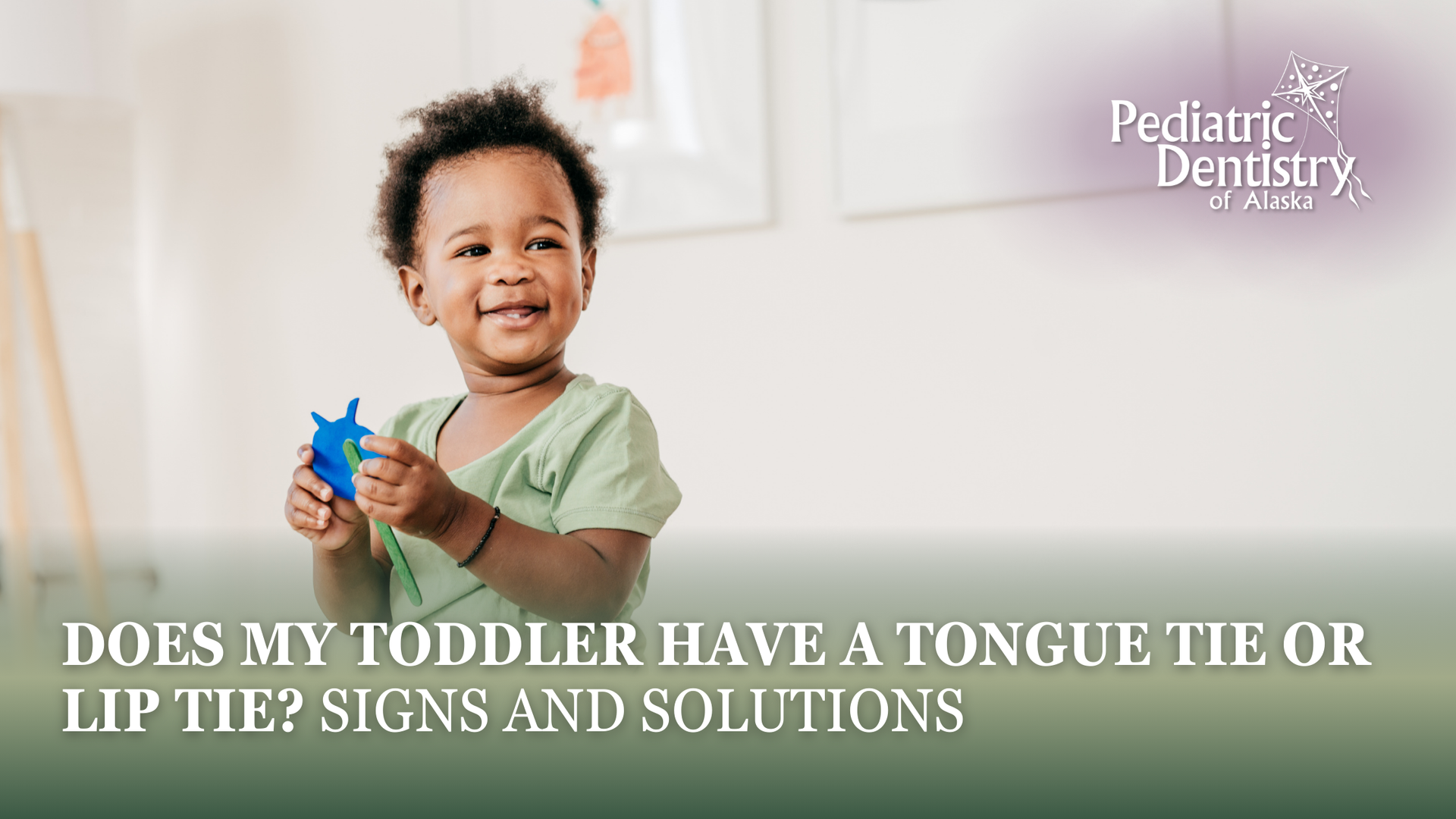Does My Toddler Have a Tongue Tie or Lip Tie? Signs and Solutions

Source: Dr. Marketing
Every parent wants their toddler to thrive—to eat well, speak clearly, and grow with confidence. But what happens when subtle oral restrictions begin to interfere with these milestones? Tongue tie and lip tie are two conditions that can have a significant impact on your toddler’s daily life. Though they are often overlooked, they can quietly cause challenges in feeding, speech development, oral hygiene, and even sleep.
If you have noticed signs of frustration during meals, delays in speech, or difficulty with brushing teeth, it may be time to consider whether a tongue tie or lip tie could be the underlying cause. In this blog, we will take an in-depth look at what these conditions are, how they affect toddlers, and how professional care can make a meaningful difference.
What Is a Tongue Tie or Lip Tie?

Let us begin by understanding what these conditions actually involve.
A tongue tie, or ankyloglossia, is a condition where the lingual frenulum—the small band of tissue connecting the underside of the tongue to the floor of the mouth—is unusually tight, short, or thick. This restriction can limit the tongue’s range of motion, making everyday oral functions more difficult.
A lip tie refers to a similar restriction, this time in the labial frenulum—the tissue that connects the upper lip to the gum just above the front teeth. When this tissue is too tight or improperly attached, it can prevent the upper lip from moving freely.
Both conditions are congenital, meaning they are present at birth. However, the impact may not fully present itself until the toddler years, when feeding, speaking, and oral care become more complex.
The Developmental Impact: How Tongue and Lip Ties Affect Toddlers

During the toddler years, children undergo rapid developmental changes. They begin forming full sentences, transitioning to solid foods, and learning basic oral hygiene skills. Tongue and lip ties can interfere with these milestones in subtle but impactful ways.
Feeding Challenges
One of the earliest and most noticeable effects of tongue or lip tie is difficulty with feeding. In toddlers, this might appear as picky eating, slow chewing, or reluctance to try new textures. Since the tongue plays a critical role in moving food around the mouth, breaking it down, and coordinating swallowing, any restriction in movement can disrupt the entire process.
Children with tongue ties often gag or choke more frequently when eating, while those with lip ties may have trouble keeping their mouths closed while chewing. Some toddlers compensate by avoiding harder foods altogether, leading to a limited diet that may lack essential nutrients. Over time, feeding challenges can contribute to poor weight gain, nutritional deficiencies, and negative mealtime associations that affect both the child and the family dynamic.
Speech Development and Articulation
As toddlers begin to express themselves through speech, a restricted tongue can delay or distort this development. Producing sounds such as “t,” “d,” “l,” “r,” and “th” requires the tongue to move upward or forward. If it cannot, the child may substitute sounds, slur words, or avoid certain words altogether.
Parents may notice that their child is behind peers in language development or that speech sounds unclear to others. While not all speech issues stem from tongue tie, restricted oral movement can be a contributing factor, especially if other signs are present. Early speech difficulties can affect social interactions, self-esteem, and school readiness, making early intervention especially important.

Oral Hygiene and Tooth Development
As toddlers grow, they begin learning to brush their teeth and develop oral hygiene habits. Tongue and lip ties can make this more difficult.
A tight upper lip can limit access to the front teeth, making it uncomfortable or painful to brush effectively. Children may resist brushing or find flossing difficult, especially if the tissue becomes irritated. At the same time, the tongue plays an important self-cleansing role by helping remove food particles from the teeth and cheeks. Limited tongue motion can reduce this function, increasing the risk of cavities and bad breath.
Additionally, a significant lip tie can contribute to spacing between the front teeth or delay in proper tooth eruption. In some cases, untreated restrictions may increase the need for orthodontic care later in childhood.
Disrupted Sleep and Breathing Patterns
Though less commonly discussed, tongue and lip ties can also contribute to sleep-related issues. A restricted tongue may rest low in the mouth, leading to mouth breathing and improper tongue posture during rest. This can narrow the airway and contribute to snoring or disrupted sleep.
Toddlers may experience frequent night wakings, restless sleep, or daytime fatigue. These symptoms are sometimes mistaken for behavioral concerns or sleep regression, when in fact the cause may lie in the structure and function of the oral tissues.
Signs to Watch for in Toddlers

Parents are often the first to notice subtle patterns in their toddler’s behavior—especially when everyday tasks such as eating or speaking seem more difficult than expected. While tongue ties and lip ties are not always immediately visible, they often reveal themselves through daily struggles that may at first appear unrelated.
Here are some signs to be aware of:
- Difficulty chewing or swallowing solid foods
- Gagging, choking, or messy eating
- Strong preference for soft or pureed foods
- Delayed or unclear speech
- Difficulty brushing teeth or discomfort during oral care
- Excessive drooling beyond the toddler stage
- Gaps between the front teeth
- Restless sleep or mouth breathing
- Frustration or tantrums during meals
In some cases, you may be able to see a tight band of tissue under the tongue or lip, but visible signs alone do not confirm a diagnosis. The most reliable indicator is how the restriction affects daily function. If you are noticing any of these challenges, it is worth seeking a professional evaluation to determine whether a tongue or lip tie may be the cause.
How Professional Evaluation Helps

If you suspect a tongue or lip tie, the best next step is a professional evaluation by a pediatric dentist or other qualified oral health provider. Evaluation involves more than just looking at the tissue—it includes assessing how the restriction affects feeding, speech, oral hygiene, and overall function.
In many cases, the assessment includes a collaborative team approach. Depending on your child’s symptoms, your provider may recommend consulting with a speech-language pathologist, myofunctional therapist, or feeding specialist to ensure a comprehensive treatment plan.
Treatment Options: Releasing Restrictions with Care

When a tongue or lip tie is confirmed and causing functional issues, treatment is typically recommended. The most common and effective method is a procedure called a frenectomy.
What Is a Frenectomy?
A frenectomy involves releasing the tight or restrictive tissue using a specialized tool or soft-tissue laser. The procedure is quick and minimally invasive, often completed in a single visit. In many practices, lasers are used because they reduce bleeding, minimize discomfort, and promote faster healing. The result is increased mobility of the tongue or lip, which can immediately improve oral function.
What to Expect After Treatment
After the frenectomy, your provider will guide you through specific post-care instructions to support healing and prevent reattachment. These may include oral stretches, gentle massage, or follow-up visits to monitor progress.
In some cases, therapy may continue after the procedure to help your toddler learn new patterns of movement for speech or feeding. This ensures long-term success and maximizes the benefits of the release.
Why Early Intervention Matters

The earlier a restriction is identified and treated, the more easily the child can adapt. Toddlers are at a prime developmental stage where changes in function can quickly lead to improved habits, clearer speech, and more enjoyable mealtimes.
Parents often report noticeable improvements within days or weeks of treatment—such as a toddler trying new foods, speaking with greater clarity, or brushing their teeth more willingly. These positive changes can ripple out to improve social interactions, self-confidence, and family routines.
Supporting Healthy Smiles and Happy Toddlers

Tongue tie and lip tie are more than just anatomical quirks. They are conditions that can affect a toddler’s entire experience of eating, speaking, sleeping, and smiling. By paying attention to the signs and seeking timely care, parents can help their children avoid unnecessary challenges and develop with greater ease.
If you have concerns about your toddler’s feeding, speech, or oral development, do not hesitate to schedule a professional evaluation. With the right guidance and care, toddlers with tongue or lip ties can overcome these obstacles and enjoy all the milestones that early childhood has to offer.
At Pediatric Dentistry of Alaska, located in Wasilla and Palmer, we are dedicated to helping children grow into healthy, confident individuals—starting with strong oral foundations. Our team provides detailed assessments, compassionate treatment, and continued support tailored to each child’s needs.
Let us help your toddler smile brighter and live more comfortably—because every child deserves the freedom to eat, speak, and laugh without limits.



